Submitted:
04 August 2023
Posted:
07 August 2023
You are already at the latest version
Abstract
Keywords:
1. Introduction
2. Stratospheric Input and Precipitation 17O
2.1. Mass-dependent fractionation coefficient
2.2. Influence of stratospheric input on D’17O
3. The D’17O Paleothermometer
3.1. Calibration
- Southern hemisphere (Antarctic): D’17O = 9.93 T (˚C) – 91.6
- Northern hemisphere: D’17O = 6.42 T (˚C) – 168.2
3.2. Temperature Reconstruction
4. Discussion
5. Conclusions
Supplementary Materials
Acknowledgments
Data Availability
References
- Aggarwal, P. K., U. Romatschke, L. Araguas-Araguas, D. Belachew, F. J. Longstaffe, P. Berg, C. Schumacher, A. Funk, Proportions of convective and stratiform precipitation revealed in water isotope ratios. Nature Geosci. 9, 624-629 (2016). [CrossRef]
- Angert, A., Cappa, C. D., DePaolo, D. J. (2004) Kinetic 17O effects in the hydrologic cycle: Indirect evidence and implications. Geochim. Cosmochim. Acta, 68, 3487-3495. [CrossRef]
- Aron, P. G. et al. (2021) Variability and Controls on δ18O, d-excess, and ∆′17O in Southern Peruvian Precipitation. J. Geophys. Res.: Atmospheres 126, e2020JD034009. [Dataset] https://agupubs.onlinelibrary.wiley.com/doi/abs/10.1029/2020JD034009. [CrossRef]
- Aron, P. G., N. E. Levin, E. J. Beverly, T. E. Huth, B. H. Passey, E. M. Pelletier, et al. Triple oxygen isotopes in the water cycle. Chem. Geol. 565, 120026 (2021). [CrossRef]
- Baldwin, M. P. et al. 100 years of progress in understanding the stratosphere and mesosphere. Met. Monographs, 59, 27-1 (2019). [CrossRef]
- Baldwin, M. P., D. W. Thompson, E. F. Shuckburgh, W. A. Norton, N. P. Gillett (2003). Weather from the stratosphere? Science, 301, 317-319.
- Barkan E., B. Luz B. Diffusivity fractionations of H216O/ H217O and H216O / H218O in air and their implications for isotope hydrology. Rapid Comm. Mass Spectr. 21, 2999–3005 (2007).
- Becagli, S. et al. (2004) Chemical and isotopic snow variability in East Antarctica along the 2001/02 ITASE traverse. Annals Glaciol. 39 473-482.
- Bhattacharya, S., M. Pal, B. Panda, M. Pradhan (2021). Spectroscopic investigation of hydrogen and triple-oxygen isotopes in atmospheric water vapor and precipitation during Indian monsoon season. Isotopes Env. Health Studies, 57 368-385. [Dataset] https://www.tandfonline.com/doi/abs/10.1080/10256016.2021.1931169. [CrossRef]
- Brinjikji, M., J. R. Lyons, Mass-independent fractionation of oxygen isotopes in the atmosphere. Rev. Mineral. Geochem. 86, 197-216 (2021). [CrossRef]
- Buizert, C., Gkinis, V., Severinghaus, J. P., He, F., Lecavalier, B. S., Kindler, P., et al., Greenland temperature response to climate forcing during the last deglaciation. Science, 345, 1177-1180 (2014). [Dataset] https://www.science.org/doi/abs/10.1126/science.1254961. [CrossRef]
- Buizert, C., T. J. Fudge, W. H. Roberts, E. J. Steig, S. Sherriff-Tadano, C. Ritz, C., et al., Antarctic surface temperature and elevation during the Last Glacial Maximum. Science, 372, 1097-1101 (2021). [Dataset] https://www.science.org/doi/abs/10.1126/science.abd2897. [CrossRef]
- Capron, E., S. O. Rasmussen, T. J. Popp, T. Erhardt, H. Fischer, A. Landais, J. B. Pedro et al. The anatomy of past abrupt warmings recorded in Greenland ice. Nature Comm. 12, 1-12 (2021). [CrossRef]
- Cuffey, K. M., Clow, G. D., Steig, E. J., Buizert, C., Fudge, T. J., Koutnik, M. et al., Deglacial temperature history of West Antarctica. Proc. Natl. Acad. Sci. 113, 14249-14254 (2016). [CrossRef]
- Cuffey, K. M., G. D. Clow, R. B. Alley, M. Stuiver, M., E. D. Waddington, R. W. Saltus, Large arctic temperature change at the Wisconsin-Holocene glacial transition. Science, 270, 455-458 (1995). [CrossRef]
- Dansgaard, W., S. J. Johnsen, H. B. Clausen, D. Dahl-Jensen, N. S. Gundestrup, C. U. Hammer, C. S. Hvidberg et al. Evidence for general instability of past climate from a 250-kyr ice-core record. Nature 364, 218-220 (1993). [CrossRef]
- Fourré, E. et al Tritium records to trace stratospheric moisture inputs in Antarctica. J. Geophys. Res.: Atmospheres, 123, 3009–3018 (2018).
- Franz, P., T. Röckmann, High-precision isotope measurements of H216O, H217O, H218O, and the Δ17O-anomaly of water vapor in the southern lowermost stratosphere. Atmos. Chem. Phys. 5, 2949-2959 (2005).
- Fu, Q., R. H. White, M. Wang, B. Alexander, S. Solomon, A. Gettelman, D. S. Battisti, P. Lin. The Brewer-Dobson circulation during the last glacial maximum. Geophys. Res. Let. 47, e2019GL086271 (2020). [CrossRef]
- Garratt, J. R., M. Segal (1988) On the contribution of atmospheric moisture to dew formation. Boundary-Layer Meteorol. 45, 209-236.
- Giménez, R., M. Bartolomé, F. Gázquez, M. Iglesias, A. Moreno (2021) Underlying climate controls in triple oxygen (16O, 17O, 18O) and hydrogen (1H, 2H) isotopes composition of rainfall (Central Pyrenees). Frontiers Earth Sci. 9 633698. [Dataset] https://www.frontiersin.org/articles/10.3389/feart.2021.633698/full#supplementary-material. [CrossRef]
- Goering, M. A., W. A. Gallus Jr, M. A. Olsen, J. L. Stanford, Role of stratospheric air in a severe weather event: Analysis of potential vorticity and total ozone. J. Geophys. Res. (Atmospheres), 106(D11), 11813-11823 (2001). [CrossRef]
- Goursaud, S., V. Masson-Delmotte, V. Favier, S. Preunkert, M. Legrand, B. Minster, M. Werner. Challenges associated with the climatic interpretation of water stable isotope records from a highly resolved firn core from Adélie Land, coastal Antarctica. The Cryosphere 13, 1297-1324 (2019). [CrossRef]
- Guillevic M., L. Bazin, A. Landais, P. Kindler, A. Orsi, V. Masson-Delmotte, T. Blunier, S. L. Buchardt, E. Capron, M. Leuenberger,P. Martinerie, F. Prié, B. M. Vinther, Spatial gradients of temperature, accumulation and δ18O-ice in Greenland over a series of Dansgaard-Oeschger events. Clim. Past 9, 1029–1051 (2013). [Dataset] https://cp.copernicus.org/articles/9/1029/2013/.
- Guillevic, M. et al. (2013) Evidence for a three-phase sequence during Heinrich Stadial 4 using a multiproxy approach based on Greenland ice core records. Clim. Past 10 2115-2133. [CrossRef]
- He, F., P. U. Clark, Freshwater forcing of the Atlantic meridional overturning circulation revisited. Nature Clim. Change 12, 449-454 (2022). [CrossRef]
- He, S. et al. (2021) Understanding tropical convection through triple oxygen isotopes of precipitation from the Maritime Continent. J. Geophys. Res.: Atmospheres 126, e2020JD033418. [Dataset] : https://agupubs.onlinelibrary.wiley.com/doi/full/10.1029/2020JD033418. [CrossRef]
- Holton, J. R., P. H. Haynes, M. E. McIntyre, A. R. Douglas, R. B. Rood, L. Pfister, Stratosphere – troposphere exchange. Rev. Geophys. 33, 40– 439 (1995).
- Houze, R. A. jr., Cloud Dynamics (Elsevier, Oxford, UK, 2014).
- Johnsen, S. J., D. Dahl-Jensen, N. Gundestrup, J. P. Steffensen, H. B. Clausen, H. Miller, V. Masson-Delmotte, A. E. Sveinbjörnsdottir, J. White. Oxygen isotope and palaeotemperature records from six Greenland ice-core stations: Camp Century, Dye-3, GRIP, GISP2, Renland and NorthGRIP. J. Quat. Sci. 16, 299-307 (2001). [CrossRef]
- Jouzel, J., F. Vimeux, N. Caillon, G. Delaygue, G. Hoffmann, V. Masson-Delmotte, and F. Parrenin. Magnitude of isotope/temperature scaling for interpretation of central Antarctic ice cores. J. Geophys. Res.: Atmospheres 108, D12 (2003). [CrossRef]
- Jouzel, J., R. B. Alley, K. M. Cuffey, W. Dansgaard, P. Grootes, G. Hoffmann, S. J. Johnsen et al. Validity of the temperature reconstruction from water isotopes in ice cores. J. Geophys. Res.: Oceans. 102, 26471-26487 (1997). [CrossRef]
- Jouzel, Jean, Gilles Delaygue, Amaelle Landais, Valérie Masson-Delmotte, Camille Risi, and Françoise Vimeux. Water isotopes as tools to document oceanic sources of precipitation. Water Resources Res. 49, 7469-7486 (2013). [CrossRef]
- Kaseke, K. F. et al. (2018) Precipitation origins and key drivers of precipitation isotope (18O, 2H, and 17O) compositions over Windhoek. J. Geophys. Res.: Atmospheres 123, 7311-7330. [Dataset] https://agupubs.onlinelibrary.wiley.com/doi/10.1029/2018JD028470. [CrossRef]
- Kindler P., Guillevic M., Baumgartner M., Schwander J., Landais A., Leuenberger M., Spahni R., Capron E., Chappellaz J., Temperature reconstruction from 10 to 120 kyr b2k from the NGRIP ice core. Clim. Past 10, 887–902 (2014). [Dataset] https://cp.copernicus.org/articles/10/887/2014. [CrossRef]
- Lal D., B. Peters, Encyclopedia of Physics, 46/2 (Springer-Verlag, Berlin, 1967).
- Landais, A. et al. (2012) Triple isotopic composition of oxygen in surface snow and water vapor at NEEM (Greenland). Geochim. Cosmochim. Acta 77, 304-316. [Dataset] https://www.sciencedirect.com/science/article/abs/pii/S0016703711006740?via%3Dihub. [CrossRef]
- Landais, A., A. Ekaykin, E. Barkan, R. Winkler, and B. Luz (2012) Seasonal variations of 17 O-excess and d-excess in snow precipitation at Vostok station, East Antarctica. J. Glaciol. 58, 725-733. [Dataset] https://www.cambridge.org/core/journals/journal-of-glaciology/article/seasonal-variations-of-17-oexcess-and-dexcess-in-snow-precipitation-at-vostok-station-east-antarctica/F28723253C3A28D0E5C9A46FA58FABE9.
- Landais, A. et al. (2018) Ice core evidence for decoupling between midlatitude atmospheric water cycle and Greenland temperature during the last deglaciation. Clim. Past 14 1405-1415. [Dataset] https://cp.copernicus.org/articles/14/1405/2018/. [CrossRef]
- Landais, A., E. Barkan, B. Luz, Record of δ18O and 17O-excess in ice from Vostok Antarctica during the last 150,000 years. Geophys. Res. Lett, 35 (2008). [Dataset] https://agupubs.onlinelibrary.wiley.com/doi/full/10.1029/2007GL032096. [CrossRef]
- Landais, A., E. Barkan, D. Yakir, B. Luz, The triple isotopic composition of oxygen in leaf water. Geochim. Cosmochim. Acta, 70, 4105-4115 (2006). [CrossRef]
- Landais, A., J. Lathiere, E. Barkan, and B. Luz. Reconsidering the change in global biosphere productivity between the Last Glacial Maximum and present day from the triple oxygen isotopic composition of air trapped in ice cores. Global Biogeochem. Cycles 21, (2007). [CrossRef]
- Lin, Y., R. N. Clayton, L. Huang, N. Nakamura, J. R. Lyons, J. R. Oxygen isotope anomaly observed in water vapor from Alert, Canada and the implication for the stratosphere. Proc. Natl. Acad. Sci., 110,15608-15613 (2013). [Dataset] https://www.pnas.org/doi/full/10.1073/pnas.1313014110. [CrossRef]
- Luz, B. E. Barkan, Variations of 17O/16O and 18O/16O in meteoric waters. Geochim. Cosmochim. Acta, 74, 6276-6286 (2010). [Dataset] https://www.sciencedirect.com/science/article/abs/pii/S0016703710004643. [CrossRef]
- Luz, B., E. Barkan, M. L. Bender, M. H. Thiemens, K. A. Boering (1999) Triple-isotope composition of atmospheric oxygen as a tracer of biosphere productivity. Nature 400, 547-550.
- Matejka, T. J., R. A. Houze Jr, P. V. Hobbs, Microphysics and dynamics of clouds associated with mesoscale rainbands in extratropical cyclones. Quarterly J. Royal Met. Soc. 106, 29-56 (1980).
- Meijer, H. A. J., W. J. Li (1998) The use of electrolysis for accurate δ17O and δ18O isotope measurements in water. Isotopes Env. Health Studies 34 349-369.
- Miller, M. F., Pack, A., Why measure 17O? Historical perspective, triple-isotope systematics and selected applications. Rev. Min. Geochem. 86, 1-34 (2021). [CrossRef]
- Orsi, Anais J., et al. The recent warming trend in North Greenland. Geophys. Res. Let. 44, 6235-6243 (2017). [CrossRef]
- Pang, H. et al. (2019) Influence of summer sublimation on δD, δ18O, and δ17O in precipitation, East Antarctica, and implications for climate reconstruction from ice cores. J. Geophys. Res.: Atmospheres 124, 7339-7358. [CrossRef]
- Pang, H., P. Zhang, S. Wu, J. Jouzel, H. C. Christian Steen-Larsen, K. Liu, W. Zhang et al. The dominant role of Brewer–Dobson circulation on 17O-excess variations in snow pits at Dome A, Antarctica. J. Geophys. Res.: Atmospheres: e2022JD036559 (2022).
- Petit, J., J. Jouzel, D. Raynaud, et al. Climate and atmospheric history of the past 420,000 years from the Vostok ice core, Antarctica. Nature 399, 429–436 (1999). [Dataset] https://cdiac.ess-dive.lbl.gov/ftp/trends/temp/vostok/vostok.1999.temp.dat. [CrossRef]
- Proposito, M. et al. (2002) Chemical and isotopic snow variability along the 1998 ITASE traverse from Terra Nova Bay to Dome C, East Antartica. Annals Glaciol. 35, 187-194.
- Reichler, T., J. Kim, E. Manzini, J. Kröger, A stratospheric connection to Atlantic climate variability. Nature Geosci. 5, 783-787 (2012). [CrossRef]
- Roscoe, H. K.: Possible descent across the “Tropopause” in Antarctic winter, Adv. Space Res., 33, 7, 1048-1052 (2004).
- Rosenlof, K.H. Seasonal cycle of the residual mean meridional circulation in the stratosphere, J. Geophys. Res. 100 (D3), 5173–5191 (1995). [CrossRef]
- Schmidt, G. A., G. Hoffmann, D. T. Shindell, Y. Hu. Modeling atmospheric stable water isotopes and the potential for constraining cloud processes and stratosphere-troposphere water exchange. Journal of Geophysical Research: Atmospheres 110, D21 (2005). [CrossRef]
- Schmidt, Gavin A., Allegra N. LeGrande, and Georg Hoffmann. Water isotope expressions of intrinsic and forced variability in a coupled ocean-atmosphere model. J. Geophys. Res: Atmospheres 112, D10 (2007). [CrossRef]
- Schoenemann, S. W. et al. (2014) Triple water-isotopologue record from WAIS Divide, Antarctica: Controls on glacial-interglacial changes in 17O-excess of precipitation. J. Geophys. Res.: Atmospheres 119, 8741-8763. [Dataset] https://agupubs.onlinelibrary.wiley.com/doi/full/10.1002/2014JD021770. [CrossRef]
- Severinghaus J. P., Brook E. J., Abrupt climate change at the end of the last glacial period inferred from trapped air in polar Ice. Science 286, 930–934 (1999). [CrossRef]
- Sharp, Z., J. A. G. Wostbrock, A. Pack, Mass-dependent triple oxygen isotope variations in terrestrial materials. Geochem. Persp. Lett. 7, 27-32 (2018). [CrossRef]
- Sherwood, S. C., R. Roca, T. M. Weckwerth, N. G. Andronova, Tropospheric water vapor, convection, and climate. Rev. Geophys. 48, RG2001 (2009).
- Surma, J., Assonov, S., Herwartz, D., Voigt, C. and Staubwasser, M.: The evolution of 17O-excess in surface water of the arid environment during recharge and evaporation, Sci. Rep., 8, 4972, ( 2018).
- Steig, E. J., T. R. Jones, A. J. Schauer, E. C. Kahle, V. A. Morris, B. H. Vaughn, L. Davidge, J. W. C. White, Continuous-flow analysis of δ17O, δ18O and δD of H2O on an ice core from the South Pole. Front. Earth Sci. 9, 640292 (2021). [Dataset] https://www.frontiersin.org/articles/10.3389/feart.2021.640292/full.
- Stohl, A., et al. (2003) Stratosphere – troposphere exchange: a review and what we have learned from STACCATO. J. Geophys. Res. 108(D12) 8516. [CrossRef]
- Stohl, A., H. Sodemann, Characteristics of atmospheric transport into the Antarctic troposphere. J. Geophys. Res.- Atmospheres, 115(D2) (2010). [CrossRef]
- Thiemens, M.H. History and applications of mass-independent isotope effects. Annu. Rev. Earth Planet. Sci. 34, 217-262 (2006). [CrossRef]
- Thompson, D. W., & Solomon, S. (2002). Interpretation of recent Southern Hemisphere climate change. Science, 296(5569), 895-899. [CrossRef]
- Tian, C., L. Wang, (2019) Stable isotope variations of daily precipitation from 2014–2018 in the central United States. Sci. Data, 6, 1-8. [Dataset] https://www.nature.com/articles/s41598-018-25102-7#Sec20. [CrossRef]
- Touzeau, A. et al. (2016) Acquisition of isotopic composition for surface snow in East Antarctica and the links to climatic parameters. The Cryosphere 10, 837-852. [Dataset] https://hal-insu.archives-ouvertes.fr/insu-01388903. [CrossRef]
- Uechi, Y., R. Uemura (2019) Domnant influence of the humidity in the moisture source region on the 17O-excess in precipitation on a subtropical island. Earth Planet. Sci. Let. 513 20-28. [Dataset] : https://www.sciencedirect.com/science/article/abs/pii/S0012821X19301098.
- Uemura, R., E. Barkan, O. Abe, B. Luz, Triple isotope composition of oxygen in atmospheric water vapor, Geophys. Res. Lett. 37, L04402 (2010). [CrossRef]
- Voigt, C., D. Herwartz, C. Dorador, M. Staubwasser (2021) Triple oxygen isotope systematics of evaporation and mixing processes in a dynamic desert lake system. Hydrol. Earth System Sci. 25, 1211-1228. [Dataset] : https://hess.copernicus.org/articles/25/1211/2021/.
- Winkler, R., A. Landais, C. Risi, M. Baroni, A. Elaykin, J. Jouzel, J.R. Petit, F. Prie, B. Minster, S. Falourd, Interannual variation of water isotopologues at Vostok indicates a contribution from stratospheric water vapor. Proc. Natl. Acad. Sci. 110, 17674-17679 (2013). [Dataset] : https://cp.copernicus.org/articles/8/1/2012/. [CrossRef]
- Winkler, R., et al. (2012) Deglaciation records of 17O-excess in East Antarctica: reliable reconstruction of oceanic normalized relative humidity from coastal sites. Clim. Past 8, 1-16. [CrossRef]
- Zahn, A., P. Franz, C. Bechtel, J-U. Grooß, T. Röckmann. Modelling the budget of middle atmospheric water vapour isotopes. Atmos. Chem. Phys. 6, 2073-2090 (2006). [CrossRef]
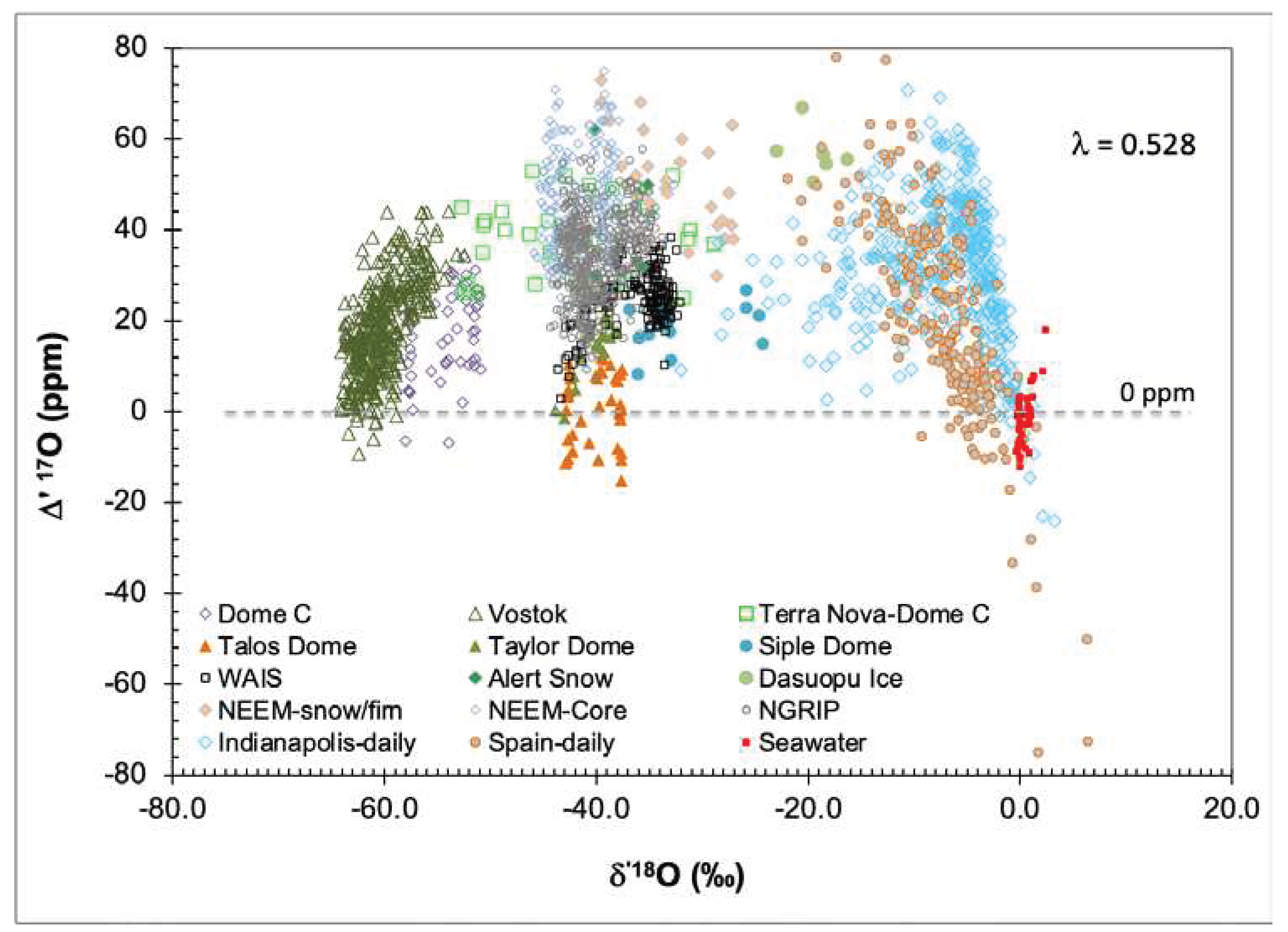
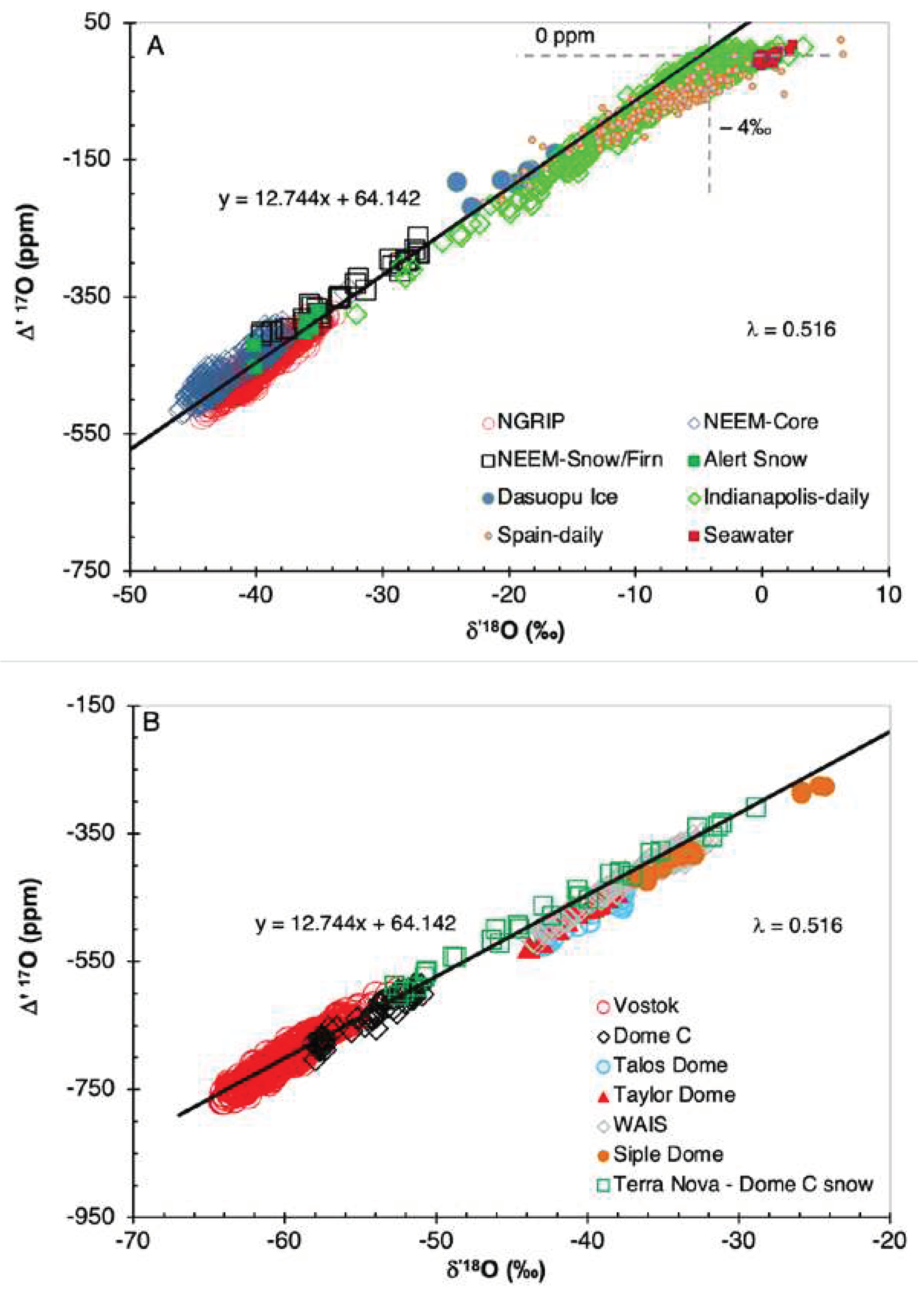
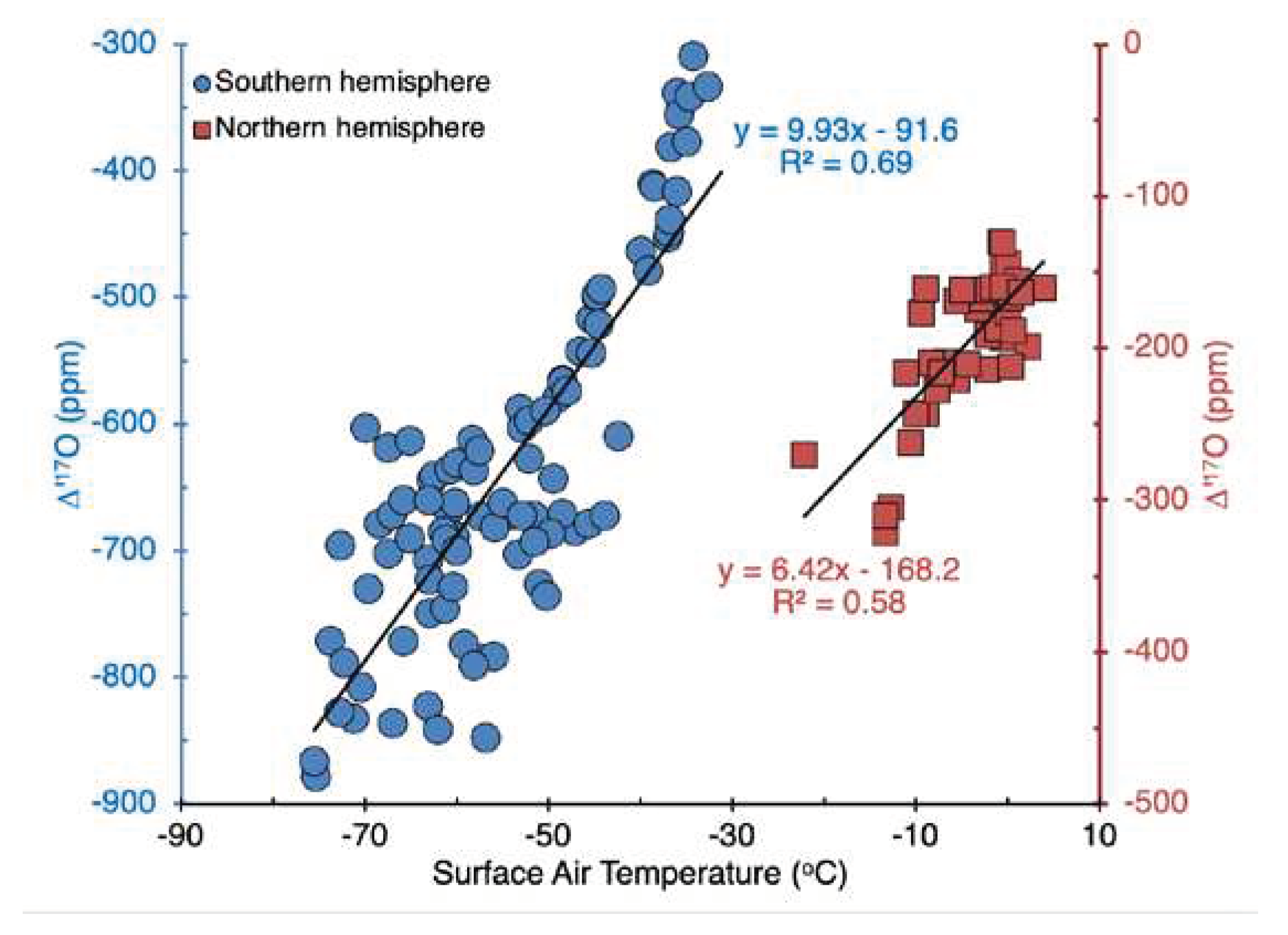
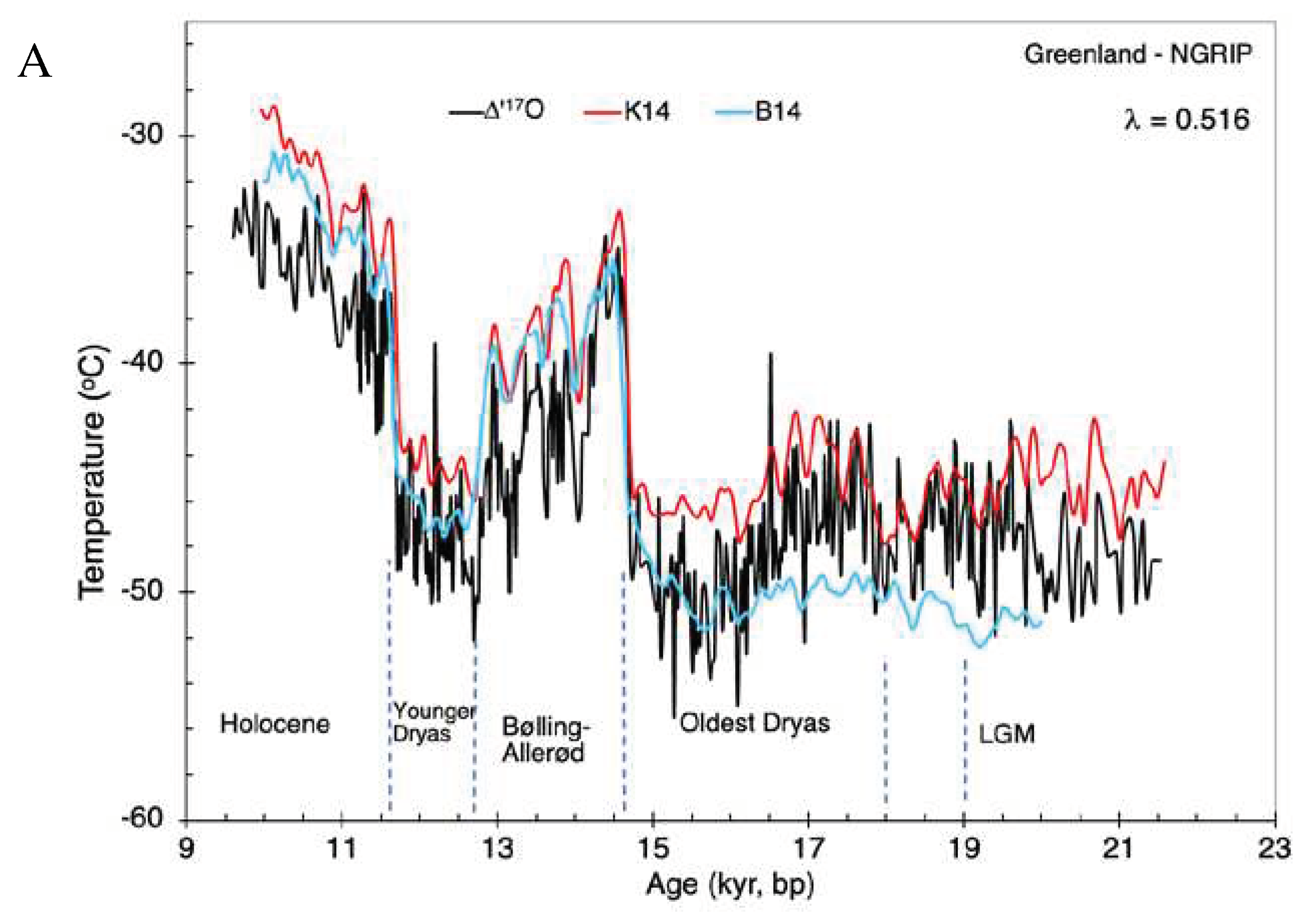

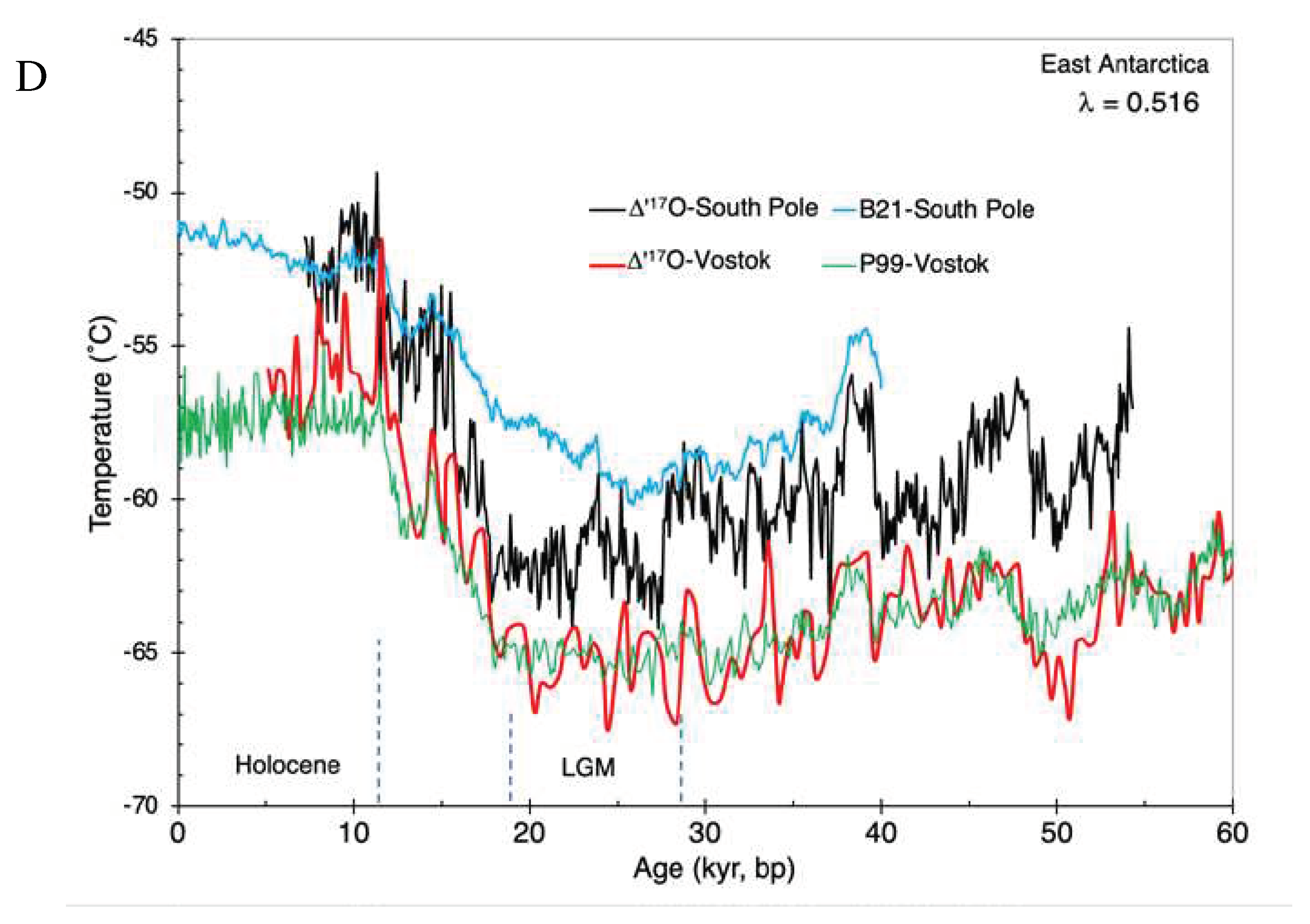
| R2 | Slope | Std. error | p-value | Intercept | Std. error | p-value | |
|---|---|---|---|---|---|---|---|
| Tropical | 0.998 | 0.521 | 0.002 | <0.01 | -0.015 | 0.011 | 0.13 |
| Tropical+subtropical | 0.998 | 0.521 | 0.001 | <0.01 | -0.012 | 0.008 | 0.17 |
| Tropical + high elevation | 0.998 | 0.523 | 0.001 | <0.01 | -0.011 | 0.009 | 0.32 |
| Tropical+subtropical + high elevation | 0.998 | 0.523 | 0.001 | <0.01 | -0.008 | 0.008 | 0.48 |
| Extratropical | 1.0 | 0.527 | 0.000 | <0.01 | 0.027 | 0.001 | <0.01 |
| Tropical+subtropical+high elev.+extratropical | 0.999 | 0.525 | 0.001 | <0.01 | -0.004 | 0.004 | 0.31 |
| Tropical+subtropical+ extraropical (d18O < –4‰) | 0.998 | 0.528 | 0.001 | <0.01 | 0.032 | 0.006 | <0.01 |
| Extratropical (d18O < –4‰) | 1.0 | 0.529 | 0.001 | <0.01 | 0.045 | 0.001 | <0.01 |
| Tropical (d18O > –4‰) | 0.998 | 0.516 | 0.003 | <0.01 | -0.001 | 0.011 | 0.93 |
| Extratropical(d18O > –4‰) | 1.0 | 0.520 | 0.001 | <0.01 | 0.001 | 0.002 | 0.52 |
| Tropical+subtropical(d18O > –4‰) | 0.999 | 0.516 | 0.002 | <0.01 | -0.002 | 0.008 | 0.80 |
| Tropical+subtropical+ extratropical (d18O > –4‰) | 0.999 | 0.516 | 0.001 | <0.01 | -0.003 | 0.004 | 0.43 |
Disclaimer/Publisher’s Note: The statements, opinions and data contained in all publications are solely those of the individual author(s) and contributor(s) and not of MDPI and/or the editor(s). MDPI and/or the editor(s) disclaim responsibility for any injury to people or property resulting from any ideas, methods, instructions or products referred to in the content. |
© 2023 by the authors. Licensee MDPI, Basel, Switzerland. This article is an open access article distributed under the terms and conditions of the Creative Commons Attribution (CC BY) license (http://creativecommons.org/licenses/by/4.0/).




